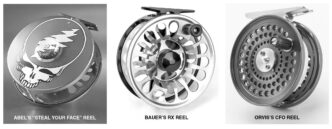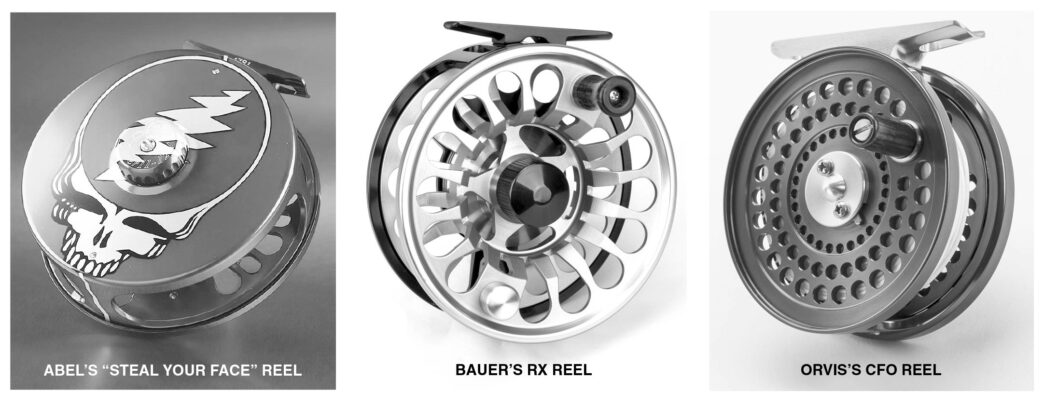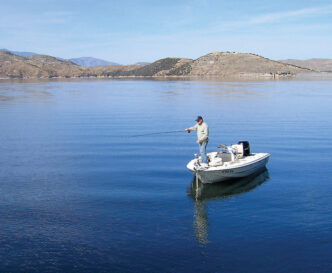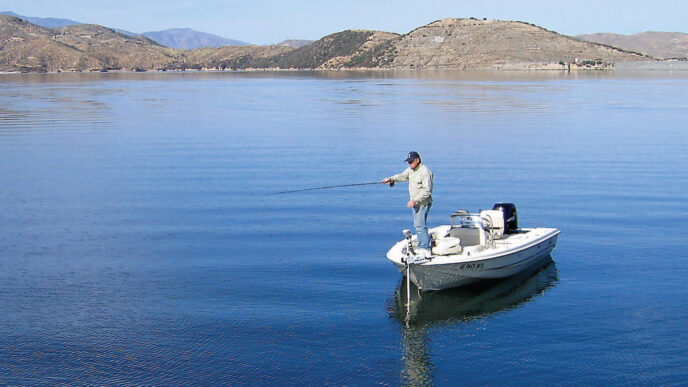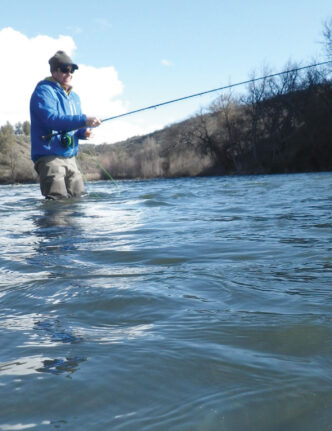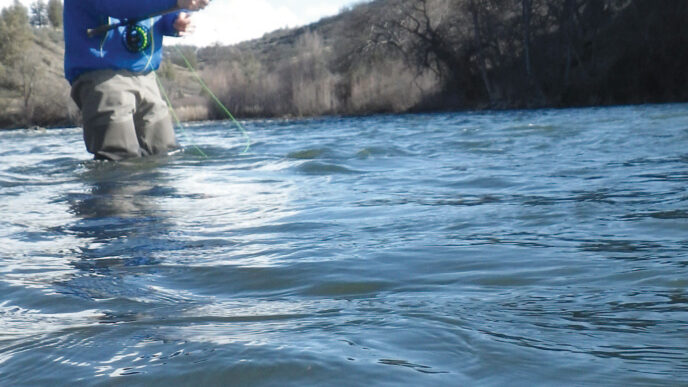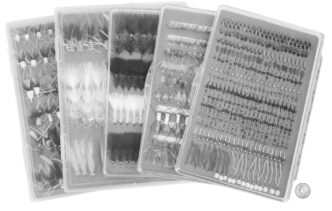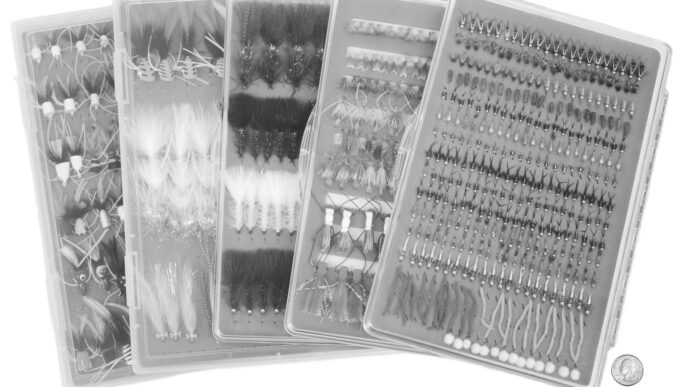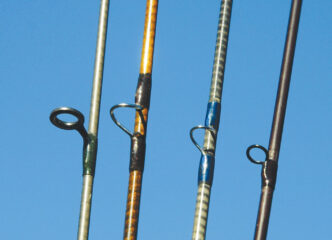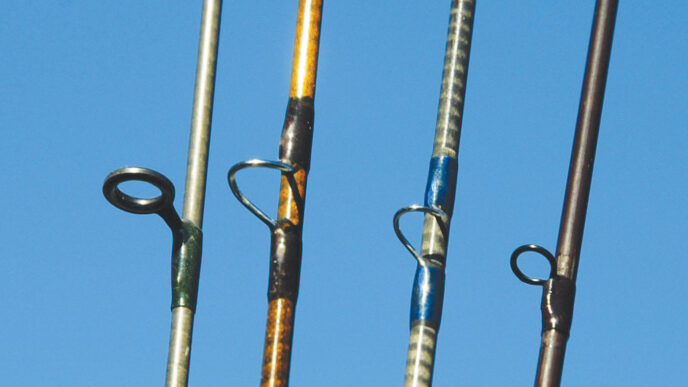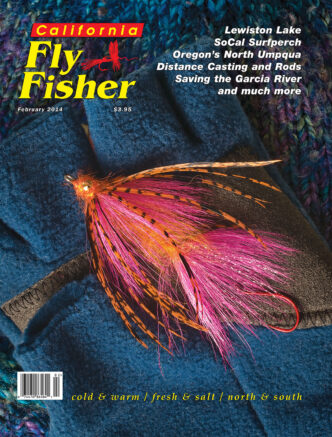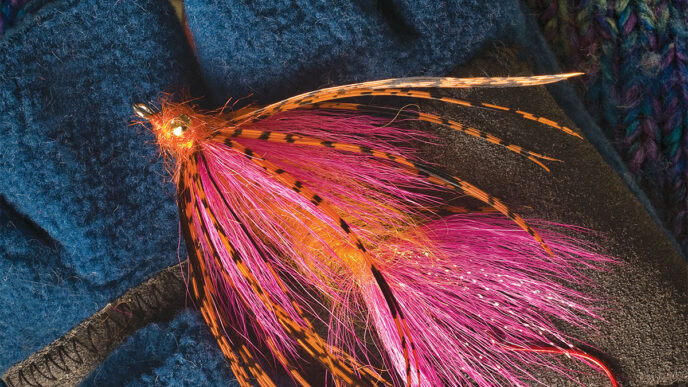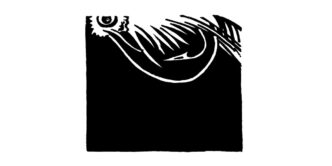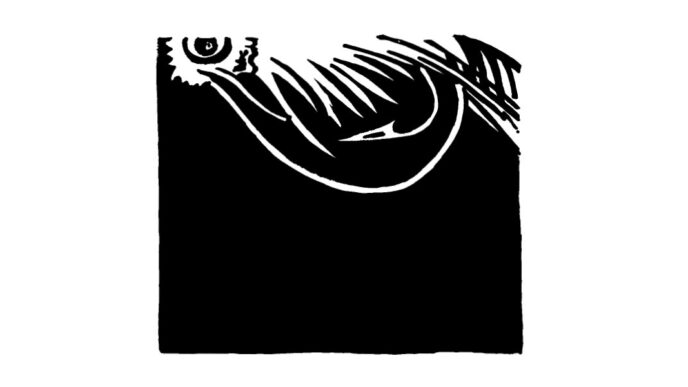It’s never been easier to find fly reels for any fly-fishing situation. And there are plenty of new products to spool on those reels, from the backing out to the line and leader.
Decent-quality reels — and you don’t need more than that for lots of fishing — are being made in Asian factories and sold by U.S. marketers. Pick a price point, and you’ll likely find a handful of possibilities, all with machined large-arbor frames and spools, easy left-hand/right-hand conversion, one-way clutch bearings, decent anodizing, and smooth drag systems.
That noted, the very highest-quality reels — exquisitely finished performance models that sell at the top end of the price spectrum — are still for the most part made in the United States. (And to some extent in England, Sweden, and Germany.) Not surprisingly, California, long a wellspring of fly-fishing innovation, is where four of the top reel companies — Abel, Bauer, Galvan, and Hatch — started out and where three still are located.
Abel was the first company to make high-quality machined fly reels available to the broad fly-fishing market and lately has been offering reels with striking artistic finishes. Today, along with their classic black anodized finish, the company lists a dozen different solid colors and as many different artfully rendered fish-scale patterns. (You want pink? Easy. Or carp? No problem.) For the company’s twenty-fifth anniversary limited-edition offering, Abel has exceeded, if not confounded, expectations. Sales manager Jeff Patterson tells the tale: “We can think of no better way to mark our twenty-fifth year than by offering a custom-designed reel that celebrates the rich American heritage of both Abel Reels and the Grateful Dead.” Hell yes! Cost for a reel finished with the Dead’s “Steal Your Face” logo is just $300 over the standard price of a comparable black Abel reel. So grab your tie-died fishing shirt, roll up a fatty, and dance on down to where the big fish rock with an Abel Super or Classic Series reel sporting that iconic skull. I’m a bit disappointed that the group’s skeleton with top hat and cane didn’t make the cut, but a Steal Your Face Abel is still unique development in the world of fly fishing. And if the Dead series doesn’t sell out by Christmas, I promise to spend New Year’s Day listening to tunes by the Carpenters.
Bauer is another fly-reel maker with California roots, though the company moved to southern Oregon a handful of years ago. In the mid-1990s, it was designer Jon Bauer who first took the large-arbor concept and applied it to top-quality discdrag models, starting the large-arbor revolution. Since then, the company has quietly updated and improved its products, which put them consistently in the top tier of fine reels. For 2014, Bauer has replaced its fine Rogue series with new RX models. Porting on both the front and back of the reels is now more open, in a teardrop shape. The drag mechanism is a further development of the carbon fiber system used in the Rogue, providing greater pressure with less strain on parts, and the RX’s bearing has been removed from the spool and packed in the frame’s sealed hub. RX models will be available for line weights 9 through 12 (sizes 5, 6 and 7 in Bauerspeak) and in a handful of colors, including new cobalt blue and coral red. The reels will start to ship in early 2014 and will retail for the same mid-$500 to high-$600 prices as the discontinued Rogues.
Nautilus Reels, made in Florida, won the Best Saltwater Reel award at the recent Las Vegas dealer show for their new CCF-X2 model. The CCF-X2 runs on hybrid ceramic bearings, has a fully sealed “dual action” carbon drag system that the company says offers “twice the drag strength (20 pounds-plus), twice the smoothness, and half the startup inertia.” I’m not sure to what the comparison is being made, but what I saw in Vegas were beautifully crafted, exceptionally attractive reels, and I’m willing to go along with the pitch. CCF-X2s are available in three models for line weights 8 to 12 and cost $435 to $550.
Orvis has some new reel models, but the one that caught my eye is the company’s reintroduction of the classic partial frame CFO click-drag model. Lots of folks argue that CFOs, a Stan Bogdan design from the mid-1970s to which Lee Wulff also contributed, are among the finest trout reels ever made. The original CFOs were manufactured in England, originally by Hardy, and were machined to final shape from aluminum castings. The new CFOs are made in the United States and are entirely machined from bar stock. I’m guessing that Ross Reels, which was purchased by Orvis along with Scientific Anglers earlier this year, had a hand in the new model’s manufacture, but Orvis isn’t saying. New CFOs have a black nickel finish that’s a little shinier than the originals and sport a rosewood crank handle. They’re otherwise indistinguishable from the earlier models, though tolerances are slightly different, so spools won’t interchange. Available in I, II and III sizes for line weights 2 through 6. Cost is $325 to $349.
Of course, there are significant exceptions to the notion that top-end reels are made only in the United States or in Europe. Sage’s new Evoke reel and some new Hardy models are made in Korea, but are designed and shepherded through production by quality-obsessed folks from Bainbridge Island and Alnwick.
Fully machined Sage Evoke reels have a modified full-frame design in which the top part of the frame is closed to contain the spool, but the bottom part is exposed, allowing the angler to palm both rims while fighting fish. The large, one revolution drag knob has 39 detents for dialing in the desired drag resistance on Sage’s sealed carbon drag system. The reels come in 8-weight and 10-weight versions ($575 and $595, respectively) in stealth/platinum, bronze/platinum and stealth/blaze color options.
Along with the Evoke, Sage introduced a couple of value-priced reels. The fully machined 3200 series has a sealed carbon drag system and costs between $199 and $239. The 2200 series are diecast aluminum reels, remachined to close tolerances, use the same sealed carbon drag system, and list at $129 to $159. The 3200s come in 3/4-weight, 5/6-weight, and 7/8-weight versions, while the 2200s add a 9/10-weight. Both of the larger sizes have the capacity for switch and Spey lines. Last year, Hardy introduced what I think is the first really good cassette flyreel design in their Ultralite CLS lineup. Instead of buying separate, relatively expensive metal spools, your line and backing go on high-impact polycarbonate cassettes that lock neatly and positively into the frame. For 2014, Hardy expanded the line to include a large model — the 9000 CLS — that will hold most Spey lines. The 9000 frame is fully machined, highly ported, and comes with three cassettes. Its price is $329.
Hardy also came up with a new sealed-drag saltwater model, the Ultralite SDS, a good-looking large-arbor model that uses woven carbon discs for a drag that, as the literature says, “delivers smooth reliable performance under the harshest of conditions.” It comes in five sizes for line weights 7 through 12 at prices from $450 to $495.
Finally, Hardy has “repatriated” production of the classic Bouglé model to Alnwick, Northumberland, from Korea, where it had been taken a few years back. Bouglés, for the uninitiated, are raised-pillar variations of the Hardy Perfect that lots of traditionalists love. New Bouglés feature a rolling pillar line guard, reversible click check, naval brass bushing and spindle, and a hand polished, deep-anodized “pearl silver” finish. They come in five sizes, from the Baby Bouglé (2-13/16 inches) to a 4-inch Bouglé, have a UK-made soft leather sheepskin case, and cost between $475 and $555.
Fly Lines
Years ago, when Scientific Anglers decided that the fly-fishing world needed floating lines in more colors than white and foam green, a shop owner told me that he couldn’t decide whether to be angry that he had to double the number of lines he stocked or happy that he was going to get additional incremental sales from folks who thought bright yellow was cool. Today, there’s hardly a fly-line company that doesn’t offer floaters lines in dual, if not multiple colors, and that variety is only an appetizer compared with the list of specialty tapers on the menu.
Over the past 20 years, weight-forward tapers have largely replaced double tapers, despite the fact that, front tapers and diameters being equal, DTs fish the same at most trout distances, roll cast better, and offer a second chance if you wreck one end. But fashion and angler imagination favor the long cast, and weight-forward lines hint at that. You can also now buy weight-forward floating lines designed for small flies, saltwater lines designed to turn over big, heavy flies, lines for cold water, lines that don’t get limp and sticky when you strip them onto the sunbaked deck of a boat from 80 degree water … and more. And of course, there are sinking lines rated by grain weight and sink rate, fat-tipped floaters for fishing indicator rigs, long-belly weight-forward lines that make mending as easy as with a double taper, and all sorts of short Skagits and Scandies and long bellies for Spey rods.
Intriguingly, although even 20 years ago the experts were telling us to attach trout leaders to butt sections with needle knots for delicacy, manufacturers are now looping both ends of many, if not most lines. From where I sit, a loop at the backing end of the running line is a great convenience if you have more lines than reels and switch around a lot, but I’m not convinced that a loop at the leader end of a trout line, no matter how small, doesn’t get in the way of delicate presentation. Then again, not having to tie a complicated Nail or Needle Knot is a strong selling point to the skill challenged or impatient. And of course, if you dislike loops, they snip off easily.
Many line manufacturers are also printing the weight and type of fly line on the line itself. Cortland started doing this 20 years ago, but the LazerLine on which it was used did not catch on, and it took until recently for other companies to pick up the practice. The tiny labels that run along the line do come in handy when you can’t remember what you stored on what spool. I still code my lines at both ends with a Sharpie pen and combinations of short and long marks for different line weights, but only because it beats dragging out the magnifying glass.
Another trend is the move by some line makers to low-stretch cores inside whatever coating forms the outside and taper of a line. Nylon cores can stretch 15 percent or more under pressure. “Low” stretch — and the figures I’m seeing for these lines run from 3 to 6 percent — means greater sensitivity to strikes and quicker hook sets. It also allows for more energy to be transferred, and transferred more quickly, from hand to rod to line when picking up a line and casting. I’ve fished a couple of very-low-stretch intermediate lines on still waters for the past few years and love them. They do feel a bit different when casting, and they can amplify the effects of a bad stroke. You need to be on your game, but what else is new? The learning curve is short.
Anyway, what’s new in the complicated world of fly lines for 2014?
Scientific Anglers, recently purchased by Orvis, didn’t introduce any new lines this fall, but their GPX Hover intermediate, introduced during the summer, won Best Freshwater Fly Line at the recent dealer show in Las Vegas. Built on what SA describes as a “low-memory core,” the Hover is intended to stay just under the surface when retrieved. It should be a great stillwater line.
At RIO, the news for fall is a series of freshwater floaters called Perception and a new line of Skagit shooting heads, all built with an ultralow-stretch core called ConnectCore. Perception single-handed lines have Rio’s Max Float tip, are coated with Agent X for slickness, are tricolored to aid in gauging distance (the “Sure Fire” system), are printed with “Easy ID” to let you quickly identify the line, and are looped at both ends. The ones I cast were sweet, front loop aside. They’re available as weight-forward floaters from 3-weight to 8-weight at $89.95.
The new Skagit Max is big-fly head, from 22 to 25 feet long, in grain weights from 425 to 750. The Skagit Max Short and Skagit iShort are powerful heads intended for shorter Spey, switch, and single-handed rods. The Max Short is 17 to 20 feet long and is offered in grain weights from 200 to 625. The Skagit iShort is an intermediate head with a short floating butt section in lengths from 18 to 21 feet and grain weights from 350 to 575. All are intended to be fished with fast-sinking sink tips and are looped at both ends. They’re all $54.95.
British fly-line manufacturer Airflo, distributed in the United States by Rajeff Sports, introduced a new technology called SuperDri that they’ve applied to five new line families. SuperDri uses new nanoengineered hydrophobic materials in the coating that actually repel water. Made of ecofriendly polyurethane, rather than PVC, SuperDri lines are super slick and reported to stay that way. They also float higher and pick up more easily than previous lines and repel dirt and scum. Built on Airflo’s low-stretch PowerCore, all five line families feature what Airflo calls Zone technology, which increases the hardness of the coating along the area where a line typically runs through the tip top on longer casts. Airflo argues that since this harder coating is compressed less by the rod tip during the haul or forward cast, the result is superior line speed and greater shootability. SuperDri Exceed models are front loaded and slightly heavy for fast rods; Elite trout taper lines are the allaround performers of the series; Distance Pro SuperDri lines have long bellies; Mend SuperDri lines are indicator nymph lines with large-diameter tips; and River and Stream SuperDri lines use Airflo’s popular delta taper. They’re $74.99, the lot of them.
Cortland, reinvigorated after some tough years, has a handful of new lines for 2014. For the trout angler, there’s a new olive green Classic Spring Creek line with a looped, extra long, supple tip that Cortland says still turns over long leaders. There’s no loop on the back end, though. They’re available as weight-forward floaters from 1-weight to 6-weight at $54. For saltwater anglers, Cortland has expanded its polyethylene/copolymer-coated lines beyond the clear lines of years past and now offers Sky Blue Liquid Crystal lines in flats tapers (weight-forward floaters from 6-weight to 9-weight) and tarpon tapers (10-weight to 12-weight versions) for $80. These lines use a blue-tinted monofilament core and are coated in such a way that the tip of the line is almost clear, while the rest of the line is a more visible, but still translucent blue.
Monic, a small manufacturer of high quality fly lines in Boulder, Colorado, originated the first decent and highly durable clear fly line in 1995. Their tropical clear line (soon followed by an all-weather clear line) earned Monic a lot of fans among anglers who chase spooky tarpon in the Florida Keys. Since then, Monic’s product offerings have gradually expanded to include a dozen or so other freshwater and saltwater lines, some clear, some opaque, all on low-stretch cores and all made with polyethylene (PE) copolymer coatings. Monic argues for the superior durability of PE coatings, but also emphasizes their lines’ ecofriendly qualities. Monic notes that there’s no easy way to recycle PVC lines and that vinyls put toxins in landfills — something to think about when you go to toss out a trashed line. For 2014, Monic has a new and different PE copolymer line called Impact that’s coming out at the end of this year, just about when the company’s patent on the earlier PE formula runs out. Impact is an ecofriendly, slick-shooting ultrahigh floater that can be used in both tropical and arctic conditions. It’s available initially only in 4-weight through 6-weight versions, but heavier line weights will follow. My experience with a prototype 5-weight floater is that the line has a bit larger tip diameter and running line that most RIO and Scientific Anglers PVC lines, so it takes up more room on a reel spool, but it floats and performs very well.
Leaders and Backing
In the leader category, RIO has some new Ultimate Presentation trout leaders coming out. Their Suppleflex leaders are made from, as Rio puts it, “the softest, most supple nylon available.”The butt section is a dark olive to fit in with subtle flyline colors, yet the unique chemistry of the leader ensures the front tippet end is completely clear. There’s a hand-tied Perfection Knot at the butt to link to the loop on the fly line tip. They come in 9-foot and 13.5-foot lengths from 3X to 7X, and cost $5.95.
Scientific Anglers is introducing leader packs with two, rather than a single leader inside. Two-leaders packs are available in nylon at $7.99 and fluorocarbon at $19.99. SA also introduced tippet material in guide spools of 100 yards at $11.99 for nylon and $43.00 for fluorocarbon. Both moves decrease per-leader or tippet cost and have the added virtue of minimizing packaging that gets put in landfills. All of SA’s leader and tippet products feature color-coded packaging: green for freshwater trout, bass, and steelhead products, blue for saltwater flats or big-fly versions, and orange for fluorocarbon.
Finally, Hatch, makers of fine fly reels, has introduced a new eight-strand polyethylene premium backing material. Available only in a .015-inch diameter white 68-pound-test line, it’s still a couple thousandths thinner than 20-pound Dacron or 50-pound gel-spun poly. It’s available in spools of 100, 200, 400, and 1,200 yards.



